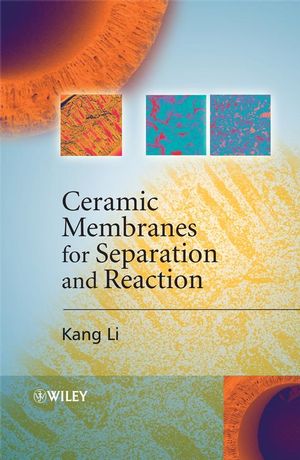Ceramic Membranes for Separation and ReactionISBN: 978-0-470-01440-0
Hardcover
316 pages
May 2007
 This is a Print-on-Demand title. It will be printed specifically to fill your order. Please allow an additional 10-15 days delivery time. The book is not returnable.
|
||||||
Ceramic Membranes and Membrane Processes.
1.1 Introduction.
1.2 Membrane Processes.
1.2.1 Gas separation.
1.2.2 Pervaporation.
1.2.3 Reverse osmosis and nanofiltration.
1.2.4 Ultrafiltration and microfiltration.
1.2.5. Dialysis.
1.2.6 Electrodialysis.
1.2.7 Membrane contactor.
1.2.8 Membrane reactors.
References.
Chapter 2.
Preparation of Ceramic Membranes.
2.1 Introduction.
2.2 Slip casting.
2.3 Tape casting.
2.4 Pressing.
2.5 Extrusion.
2.6 Sol-gel process.
2.7 Dip-coating.
2.8 Chemical vapour deposition (CVD).
2.9 Preparation of hollow fibre ceramic membranes.
2.9.1 Preparation of spinning suspension.
2.9.2 Spinning of ceramic hollow fibre precursors.
2.9.3 Sintering.
2.9.4 Example 1: Preparation of porous Al2O3 hollow fibre membranes.
2.9.5 Example 2: Preparation of TiO2/Al2O3 composite hollow fibre membranes.
2.9.6 Example 3: Preparation of dense perovskite hollow fibre membranes.
Appendix 2.1: Surface forces.
References.
Chapter 3.
Characterisation of Ceramic Membranes.
3.1 Introduction.
3.2 Morphology of membrane surfaces and cross sections.
3.3 Porous ceramic membranes.
3.3.1 Gas adsorption/desorption isotherms.
3.3.2 Permporometry.
3.3.3 Mercury porosimetry.
3.3.4 Thermoporometry.
3.3.5 Liquid displacement techniques.
(a) Bubble point method.
(b) Liquid displacement method.
3.3.6 Permeation method.
(a) Liquid permeation.
(b) Gas permeation.
3.3.7 Measurements of solute rejection.
3.4 Dense ceramic membranes.
3.4.1 Leakage test.
3.4.2 Permeation measurements.
3.4.3 XRD.
3.4.4 Mechanical strength.
Notation.
References.
Chapter 4.
Transport and Separation of Gases in Porous Ceramic Membranes.
4.1 Introduction.
4.2 Performance indicators of gas separation membranes.
4.3 Ceramic membranes for gas separation.
4.4 Transport Mechanisms.
4.4.1 Knudsen and slip flow.
4.4.2 Viscous flow.
4.4.3 Surface flow.
4.4.4 Capillary condensation.
4.4.5 Configurational or micropore diffusion.
4.4.6 Simultaneous occurrence of different mechanism.
4.5 Modification of porous ceramic membranes for gas separation.
4.6 Resistance model for gas transport in composite membranes.
4.6.1 Effect of support layers.
4.6.2 Effect of non-zeolitic pores.
4.6.3 Effect of coating.
4.7 System design.
4.7.1 Operating Schemes.
(a) Perfect mixing.
(b) Cross flow.
(c ) Parallel plug flow.
4.7.2 Design equations for membrane processes in gas separation.
(a) Perfect mixing.
(b) Cross flow.
(c) Cocurrent flow.
(d) Countercurrent flow.
Notation.
References.
Chapter 5.
Ceramic Hollow Fibre Membrane Contactors for Treatment of Gases/Vapours.
5.1 Introduction.
5.2 General review.
5.3 Operating modes and mass transfer coefficients.
5.3.1 Nonwetted mode.
5.3.2 Wetted mode.
5.3.3 Mass transfer coefficients determined from experiments.
5.4 Mass transfer in hollow fibre contactors.
5.4.1 Mass transfer in hollow fibre lumen.
5.4.2 Mass transfer across membrane.
5.4.3 Mass transfer in shell side of a contactor.
5.4.4 Nonwetted, wetted, and partially wetted conditions in a hollow fibre contactor.
5.5 Effect of chemical reaction.
5.5.1 Instantaneous reaction.
5.5.2 Fast reaction.
5.6 Design equations.
Notation.
References.
Appendix A.
Chapter 6.
Mixed Conducting Ceramic Membranes for Oxygen Separation.
6.1 Introduction.
6.2 Fundamentals of mixed conducting ceramic materials.
6.2.1 Structure of peroviskite-type of materials.
6.2.2 Doping strategies.
6.2.3 Properties of materials.
6.3 Current status in oxygen permeable membranes.
6.3.1 Pervoskite-type oxides.
Sr(Co,Fe)O3-d (SCFO).
La(Co,Fe)O3-d (LCFO).
LaGaO3(LGO).
6.3.2 Non-perovskite-type oxides.
6.3.3 Summary of ceramic oxygen permeable materials.
6.4 Dual phase membranes.
6.5 Oxygen transport.
6.5.1 Transport mechanism.
6.5.2 Transport equations.
6.5.3 Transport analysis.
6.6 Air separation.
6.6.1 Design equations.
Cocurrent flow.
Countercurrent flow.
6.6.2 Performance analysis.
Effect of operating pressures and temperatures.
Effect of flow patterns.
Effect of feed flow rate.
Effect of membrane area.
Comparison with experimental data.
Production of oxygen using hollow fibre modules.
6.7 Further development-challenges and prospects.
Notation.
References.
Chapter 7.
Mixed Conducting Ceramic Membranes for Hydrogen Permeation.
7.1 Introduction.
7.2 Proton and electron (hole) conducting materials and membranes.
7.2.1 Pervoskite-type oxides.
7.2.2 Non-pervoskite-type oxides.
7.3 Dual phase membranes.
7.4 Proton transport.
7.4.1 Transport mechanism.
7.4.2 Transport equations for mixed proton-hole conducting membranes.
7.4.3 Transport analysis.
Effect of membrane thickness.
Effect of temperature.
Effect of partial pressure of oxygen.
Comparison with experimental data.
7.5 Applications of proton conducting ceramic membranes.
7.5.1 Hydrogen production.
7.5.2 Dehydrogenation reactions.
Notation.
References.
Chapter 8.
Ceramic Membrane Reactors.
8.1 Introduction.
8.2 Membranes as product separators.
8.2.1 Microporous membrane reactors.
8.2.2 Dense ceramic membrane reactors.
8.2.2.1 Experimental investigation of a dense ceramic membrane reactor for methane coupling reaction.
8.3 Membranes as a reactant distributor.
8.3.1 Porous membrane reactors.
8.3.1.1 Techniques in modification of membrane pores.
8.3.1.2 Applications of porous ceramic membrane reactors.
8.3.1.3 Analysis of membrane reactors for elimination of DO from water.
8.3.2 Dense ceramic membranes.
8.3.2.1 Configurations of the dense ceramic membrane reactors.
8.3.2.2 Applications of the dense ceramic membrane reactors.
8.3.2.3 Experimental investigation of a dense membrane reactor for oxidative methane coupling (OMC).
Notation.
References.



